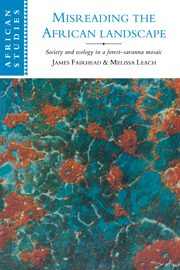Book contents
- Frontmatter
- Contents
- List of plates
- List of figures
- List of tables
- Note on authorship and research collaboration
- Acknowledgements
- Linguistic conventions
- Introduction
- 1 Convictions of forest loss in policy and ecological science
- 2 Forest gain: historical evidence of vegetation change
- 3 Settling a landscape: forest islands in regional social and political history
- 4 Ecology and society in a Kuranko village
- 5 Ecology and society in a Kissi village
- 6 Enriching a landscape: working with ecology and deflecting successions
- 7 Accounting for forest gain: local land use, regional political economy and demography
- 8 Reading forest history backwards: a century of environmental policy
- 9 Sustaining reversed histories: the continual production of views of forest loss
- 10 Towards a new forest–savanna ecology and history
- Appendix I Glossary of plant names
- Appendix II Cassette recordings of oral accounts and discussions
- Notes
- List of references
- Index
- Titles in the series
- Plate section
10 - Towards a new forest–savanna ecology and history
Published online by Cambridge University Press: 05 June 2012
- Frontmatter
- Contents
- List of plates
- List of figures
- List of tables
- Note on authorship and research collaboration
- Acknowledgements
- Linguistic conventions
- Introduction
- 1 Convictions of forest loss in policy and ecological science
- 2 Forest gain: historical evidence of vegetation change
- 3 Settling a landscape: forest islands in regional social and political history
- 4 Ecology and society in a Kuranko village
- 5 Ecology and society in a Kissi village
- 6 Enriching a landscape: working with ecology and deflecting successions
- 7 Accounting for forest gain: local land use, regional political economy and demography
- 8 Reading forest history backwards: a century of environmental policy
- 9 Sustaining reversed histories: the continual production of views of forest loss
- 10 Towards a new forest–savanna ecology and history
- Appendix I Glossary of plant names
- Appendix II Cassette recordings of oral accounts and discussions
- Notes
- List of references
- Index
- Titles in the series
- Plate section
Summary
Not all ecologists, foresters and botanists would interpret West Africa's forest–savanna mosaic in terms of past and ongoing forest loss. But over the past century, all those who have actually examined the mosaic in Kissidougou have interpreted it in this way. Close examination of the historical record and of local management practices shows not only the error in this perspective, but also what it has obscured: the creation of forest islands, their dynamics, and the enriching of open savannas with more woody vegetation forms. It is within this dynamic that Kissi- and Kuranko-speaking villagers conceive of their relationship with their landscape; a relationship with deep historical roots. Considering the landscape in terms of degradation has obscured how people live and work with ecological processes on a day to day basis, often improving land productivity and value – improvements recognised in tenurial claims. For Kissia and Kuranko, it is in part through using land and bringing it into productivity that both common and differentiated social identities and relations are realised. And in reflecting on ecology people also reflect on their relations not only with the world around them, but also with each other. While their conceptions of ecological dynamics often contrast strongly with scientific orthodoxy, they do nevertheless postulate relationships which isolated and recent scientific studies would support. It is largely these local land use and enrichment practices, and their articulation with major historical shifts in economy and polity which account for the particular course of vegetation change during this century.
- Type
- Chapter
- Information
- Misreading the African LandscapeSociety and Ecology in a Forest-Savanna Mosaic, pp. 279 - 295Publisher: Cambridge University PressPrint publication year: 1996

